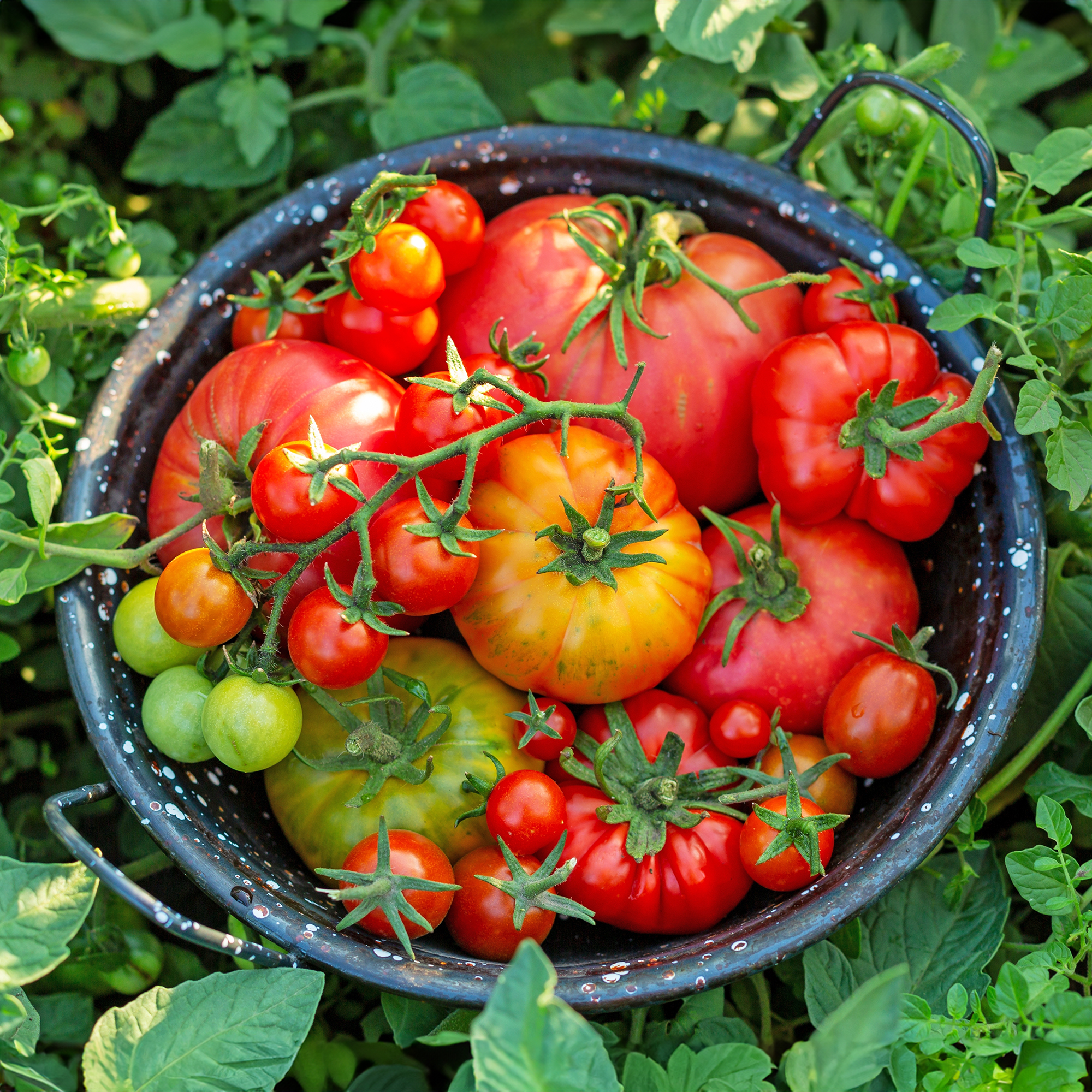Growing Tomatoes In Containers: Enjoy Bountiful Harvests In Small Spaces
Nothing says summer like homegrown tomatoes! Learn how to grow tomatoes in pots, and you'll soon be harvesting an abundant crop on the patio or balcony.
Melanie Griffiths
Growing tomatoes in containers is a space-saving way to enjoy these succulent, sweet fruits at home. Tomatoes can be grown easily in many types of containers, including patio pots, hanging baskets, and window boxes. Even small gardens can accommodate a potted tomato plant or two.
If you want to learn how to grow tomatoes but are deterred by a lack of green space, then keep reading. These versatile plants can happily reside on the lanai, patio, or even a balcony in a sunny location. If you don't have any outdoor space, then growing tomatoes indoors is a possibility.
A major benefit of growing tomatoes in pots is that you can create the optimal growing conditions. The soil can be controlled while a container set close to the home makes for easier basic maintenance such as watering, feeding, pruning, and staking. Best of all, once the fruit begins to arrive, harvesting is as simple as stepping outside your door. Learn how to grow tomatoes in pots and enjoy fresh fruits all summer.
Best Tomato Varieties for Containers
The first step to success is picking the best tomatoes for containers. Let’s start with the basics. There are two main types of tomatoes that you can grow: indeterminate and determinate.
Indeterminate tomatoes are the most common type of tomato plant. They are vining and continue to grow and produce fruit all season until the first frost. Indeterminate varieties can grow 3 to 5 feet (0.9-1.5m) tall or more and require stakes, cages, or trellises to grow upright. They also require pruning. You can grow indeterminate tomatoes in pots as long as the container is large enough for the mature plant and you provide plenty of infrastructure to hold up those rampant stems. Bear in mind that most heirloom tomatoes are indeterminate.
Determinate tomatoes are the best choice for containers. They are compact and bushy and stop growing sooner than vining tomatoes. They produce a set amount of fruit that ripens in a four-to-six-week timeframe, which is ideal for canning. Determinate varieties only grow 2 to 3 feet (60-90cm) tall and don’t require staking or pruning.
In terms of variety, any grape or cherry tomatoes can easily be grown in pots. These tend to be particularly sweet and delightful eaten fresh from the vine. But there is plenty of choice: look for plants or seeds labeled “patio,” “compact,” “dwarf,” or “bush” to make sure you choose a determinate type that does well in containers.
Sign up for the Gardening Know How newsletter today and receive a free copy of our e-book "How to Grow Delicious Tomatoes".
Larger plants should be carefully selected; look at the mature size before purchase. Bush Early Girl Hybrid is an excellent small, compact plant that will produce full-size tomatoes. San Marzano is a wonderful sauce tomato, while Celebrity has large slicing tomatoes on a big determinate plant. There are several bush beefsteak tomato plants suited to container growing, such as Bush Beefsteak.
Really, any tomato can be grown in a container provided the pot is large enough and there is plenty of support for heavy, laden vines. Browse a selection of high-performing tomato seeds in the Gardening Know How Shop.
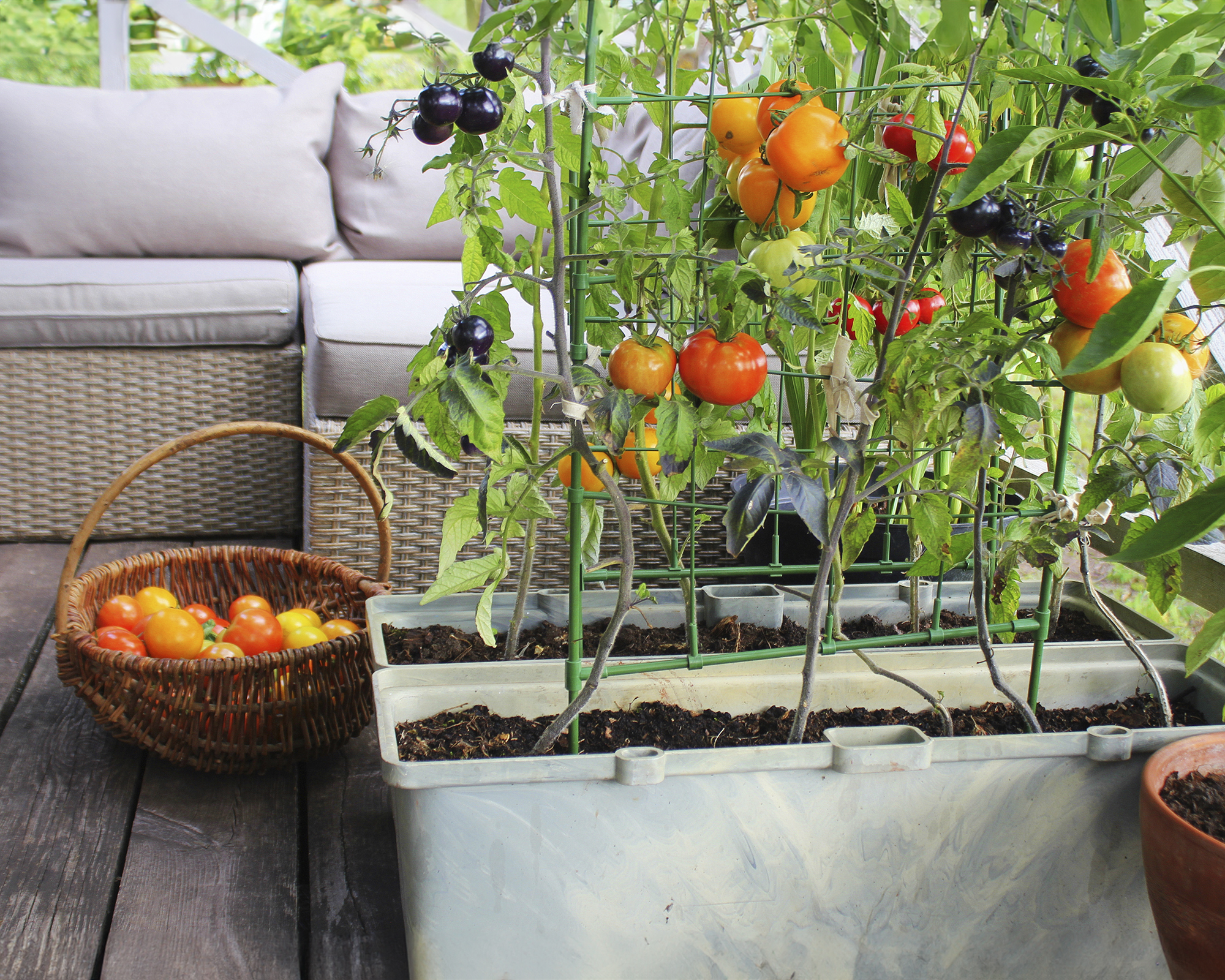
Best Types of Containers
There are many suitable types of containers to grow tomatoes at home. A popular choice is a 5-gallon bucket with holes drilled in the bottom. Wooden barrel or metal tub planters are another good option because they are wider, and tomato roots need lots of space to spread out. For a more temporary solution, fabric grow bags can be easily emptied and stored away at the end of the season. Where there isn't enough floor space, you can even plant a tomato hanging basket.
For the ultimate container solution, the EZ Self-Watering Tomato Planter, available in the Gardening Know How Shop, has an inbuilt trellis and wheels, providing an all-in-one growing solution that can be moved around when needed.
Decorative pots are a great option if you want your growing space to be ornamental as well as edible. Pots may be glazed or unglazed clay, ceramic, or even plastic. Be aware that the container material will influence how often you need to water plants. Ceramic and plastic containers will hold more moisture than an unglazed terracotta pot.
Whatever container you choose, ensure it has adequate drainage so the potting soil does not become waterlogged.
Tomato Container Size
When choosing the best tomato container size, it's a case of the bigger, the better. Pots should be at least 12 to 14 inches (30-25cm) across. Each tomato plant needs at least 12 inches (30cm) to grow and produce fruit. A depth of 12 inches (30.5cm) is the minimum necessary for most tomatoes. But the larger the plant, the more root depth it will have.
Smaller pots will dry out quickly, and you'll have to water plants more frequently, causing nutrients and minerals to wash out of the soil. This will leave your tomatoes lacking the food they need to grow, reducing yields. It can also lead to inconsistent moisture levels, a common cause of blossom end rot and fruit cracking.
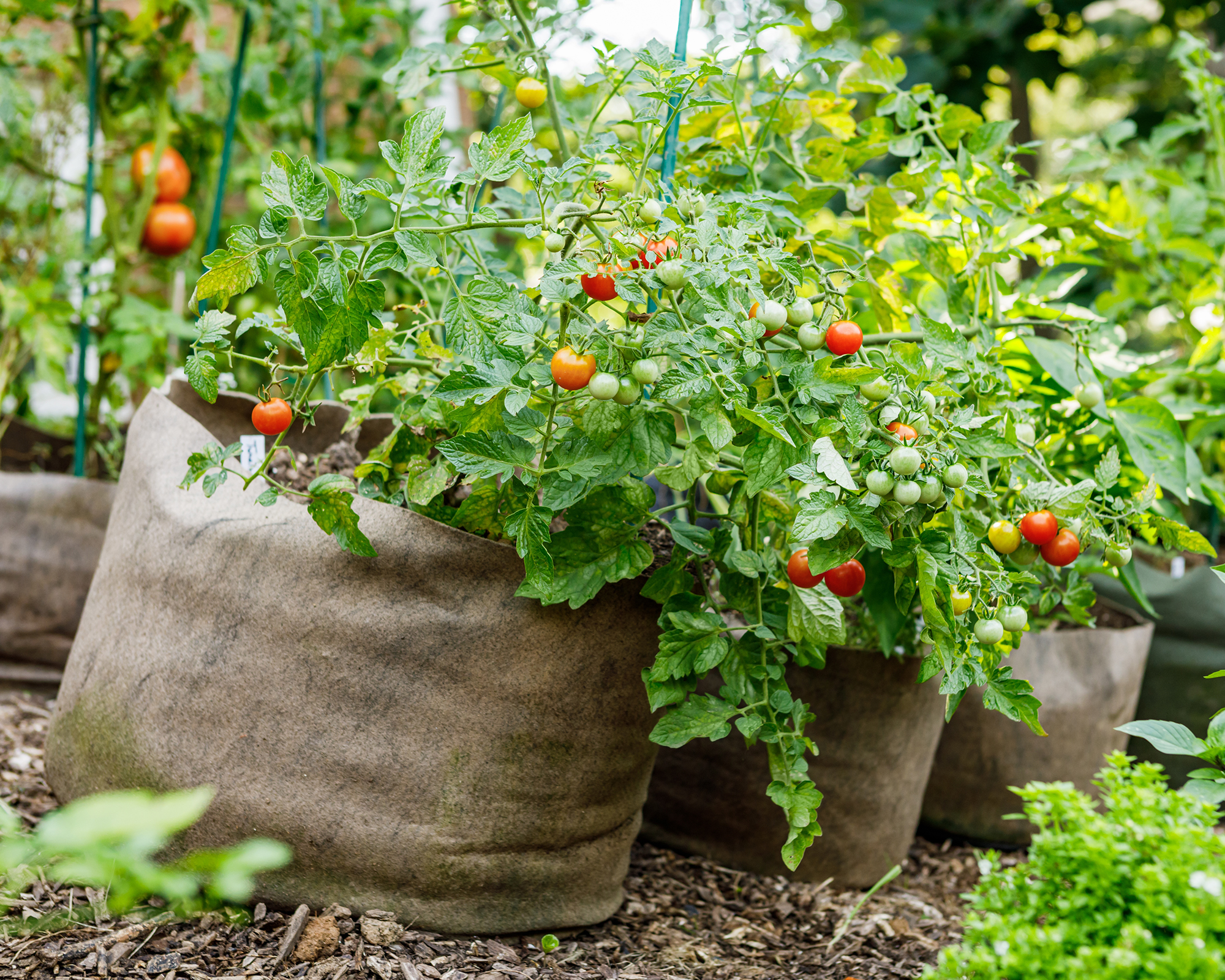
How to Grow Tomatoes in Containers
There are two ways you can grow tomatoes in containers. The first and less expensive method is to start plants from seed. Starting tomato seeds indoors five to six weeks before your last frost date will give you a head start on the growing season.
Sow seeds into pots or trays and cover with a lid to keep in humidity. The Gardening Know How Shop sells a range of professional-quality seedling trays, humidity domes, drip-irrigation lids, and growing kits to give your tomato seeds the best possible start.
To further enhance germination, use a seedling heat mat or place the container in a warm location of the house.
Once the seedlings are a few inches tall and have four sets of true leaves, separate the strongest starts to plant in containers for the rest of the summer. Harden off seedlings before transplanting to help them acclimate to the garden.
If you’re looking for a quicker, easier way to grow tomatoes, the second method is to purchase plants from the store. Choose tomatoes that are compact and green with leaves that are free of spots or discoloration.
Whether you started seeds or purchased transplants, planting tomatoes in containers and caring for them is the same. Fill your container with potting mix, leaving 2 inches (5cm) of space between the top of the pot and the soil line.
Remove your tomato plant from its container. Gently untangle the root ball to give the roots a head start and keep them from becoming bound in the pot. A good tip for planting anything, whether it’s produce or flowers, is to water plants well before transplanting. This eases their transition and starts them off right in their new home.
Create a hole for your tomato and make sure all the roots are in the soil. Backfill with potting mix, adding more as needed. Pat down the soil to remove any large air pockets, but don’t compact it too hard.
Place the container in full sun. For tomatoes that require supporting, it is best to add the cage or stake at this stage.
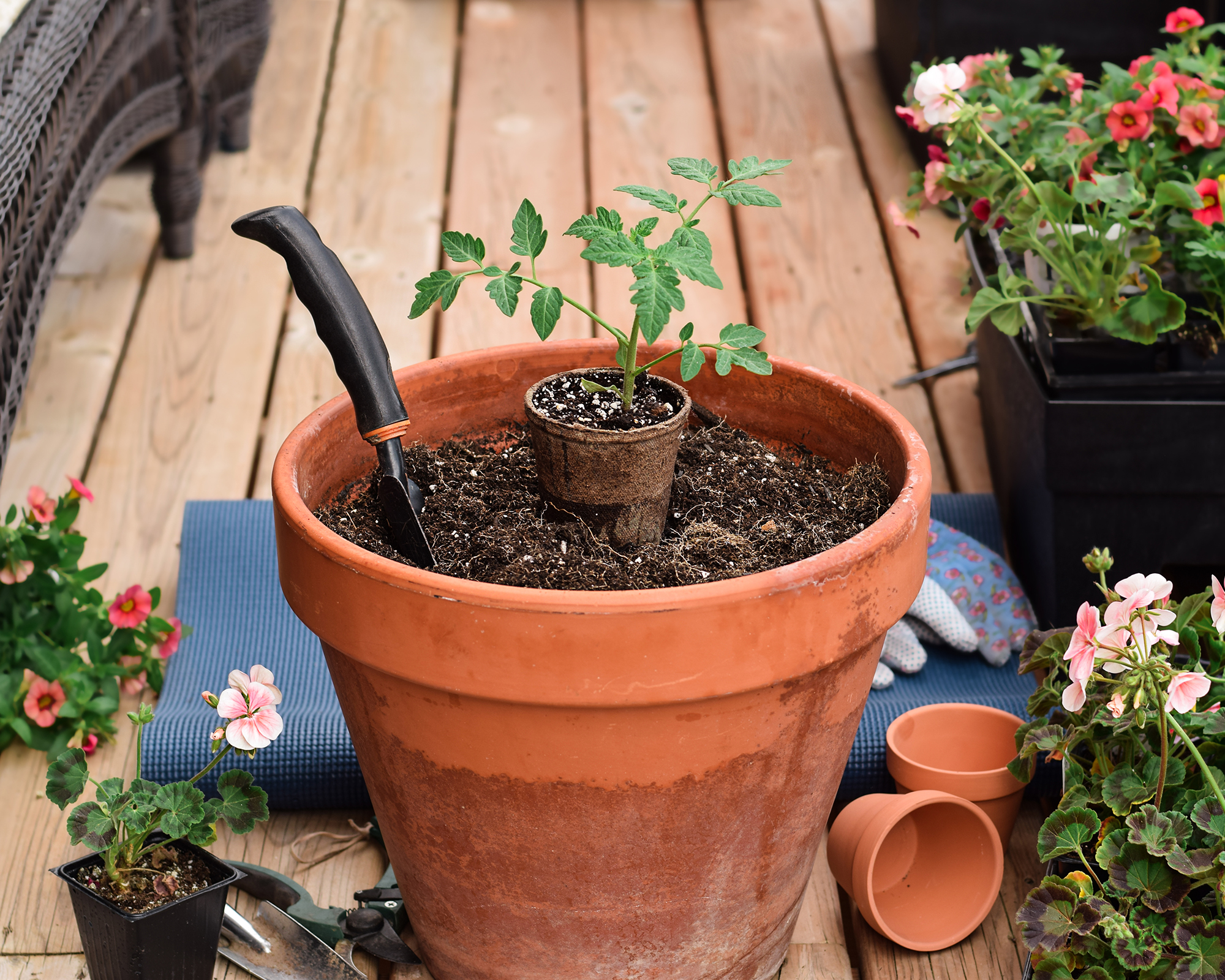
Caring for Tomatoes in Containers
Growing tomatoes in pots is easy and can yield just as much as those planted in the garden. However, you do need to meet the plant's basic care requirements.
As an additional step, consider companion planting tomatoes with beneficial flowers and herbs to ward off pests and attract pollinators, reducing the necessity to pollinate tomatoes by hand. The best herbs to plant with tomatoes include basil and oregano, while some of the best flowers to plant with tomatoes are marigolds and nasturtiums.
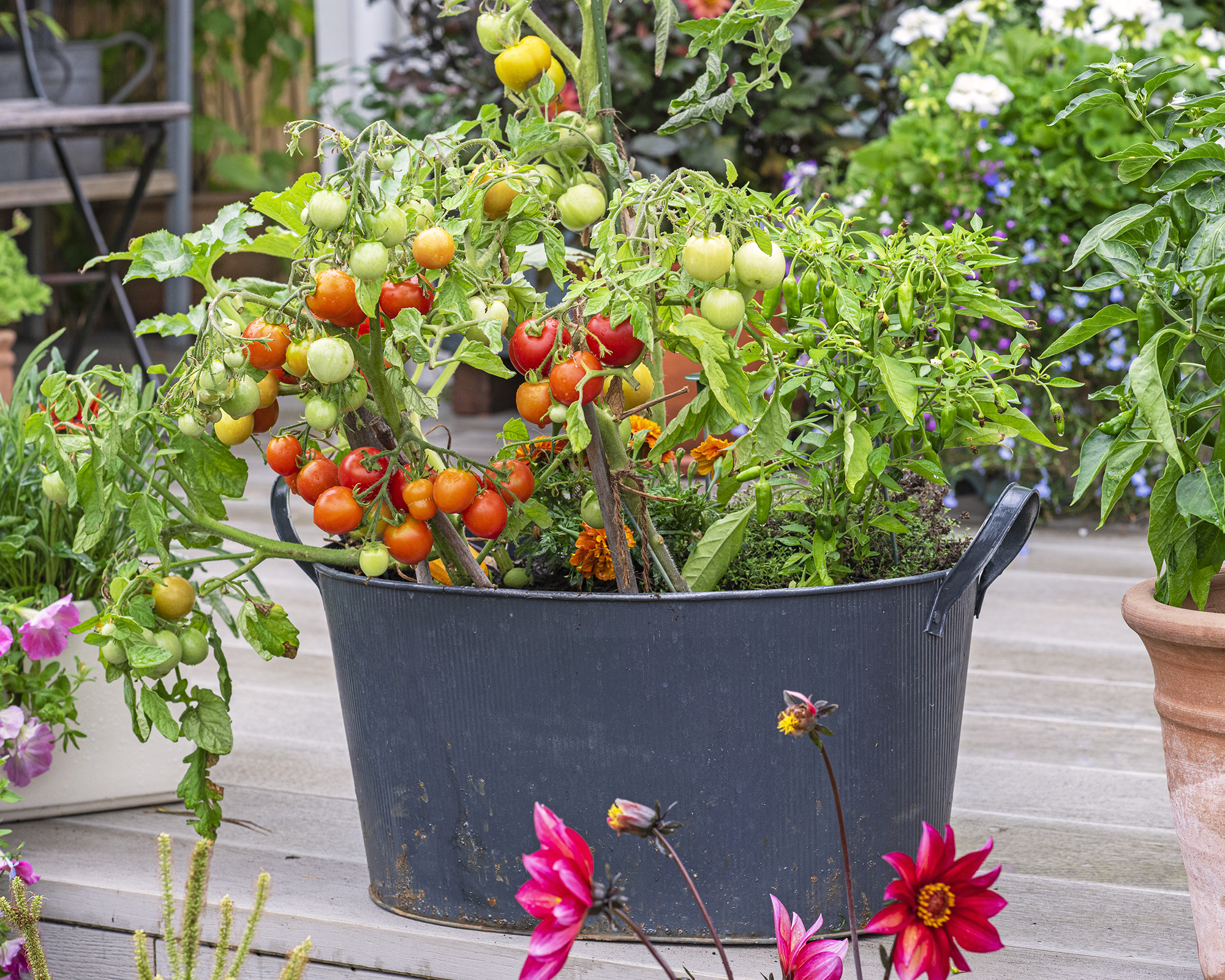
Light
Tomatoes need full sun to set fruit and be the most productive. The minimum tomato plant light requirements are six hours of sunlight a day, but eight or more is better. The more sun the plant gets, the more fruit it will produce.
If the container is on a lanai or deck, situate it where it will get the most sun. The western or southern side of the home will provide the most sun in the growing season.
Water
Tomatoes are filled with juice. When the plant is producing fruits it will need plenty of water. How often to water tomatoes depends largely on weather conditions, but container-grown tomatoes need more frequent watering than those in the ground. Poke your finger in the top two inches of soil to check if plants are dry and need a drink. In the hot summer days, this could be as often as twice per day.
Water until it percolates out of the drainage holes. Try to only get the water on the root zone and avoid wetting the leaves, as this can cause fungal disease. Do not let the container dry out completely, as this can cause the plant to abort flowers and young fruit.
A good trick to keep potted tomatoes from drying out is to use mulch or straw to hold in moisture.
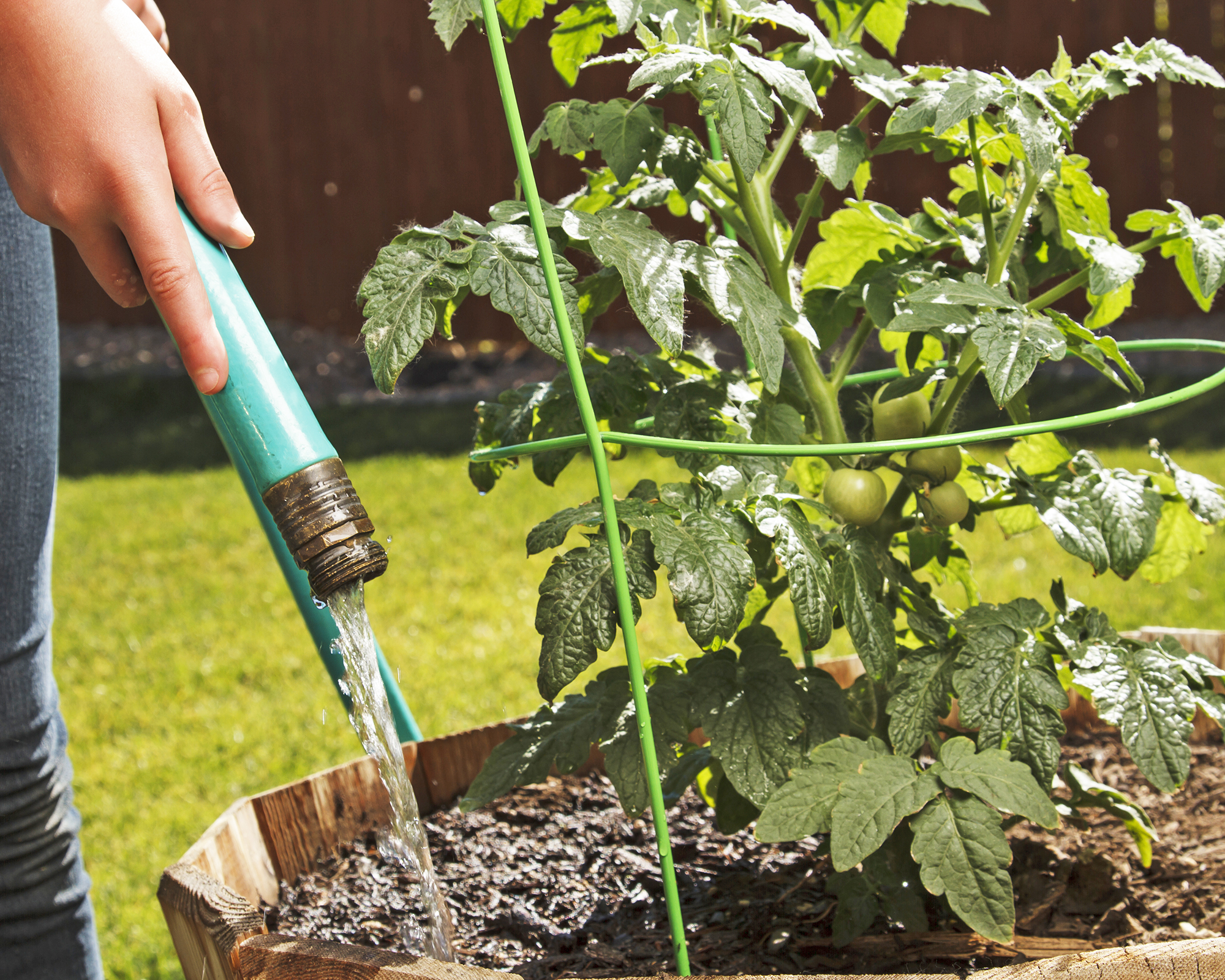
Temperature & Humidity
Tomatoes are warm season plants and must have heat to produce fruit. During the day, an ideal tomato plant temperature of between 70-82°F (21-27°C) will promote the best growth. At night, temperatures should range between 62-64°F (17-18°C).
If your plants are still producing at the end of the season, protect them from cold snaps at night by placing frost-free fabric over the plants. Very high humidity levels can impede pollination. The optimal range is 65-85% relative humidity.
Soil
The best soil for tomatoes in pots is one designed specifically for containers. Using a good potting medium will ensure your tomatoes retain proper moisture levels. It should be well-draining and slightly acidic.
Consider adding crushed eggshells to add calcium, blood meal, and compost to enhance drainage and nutrient content.
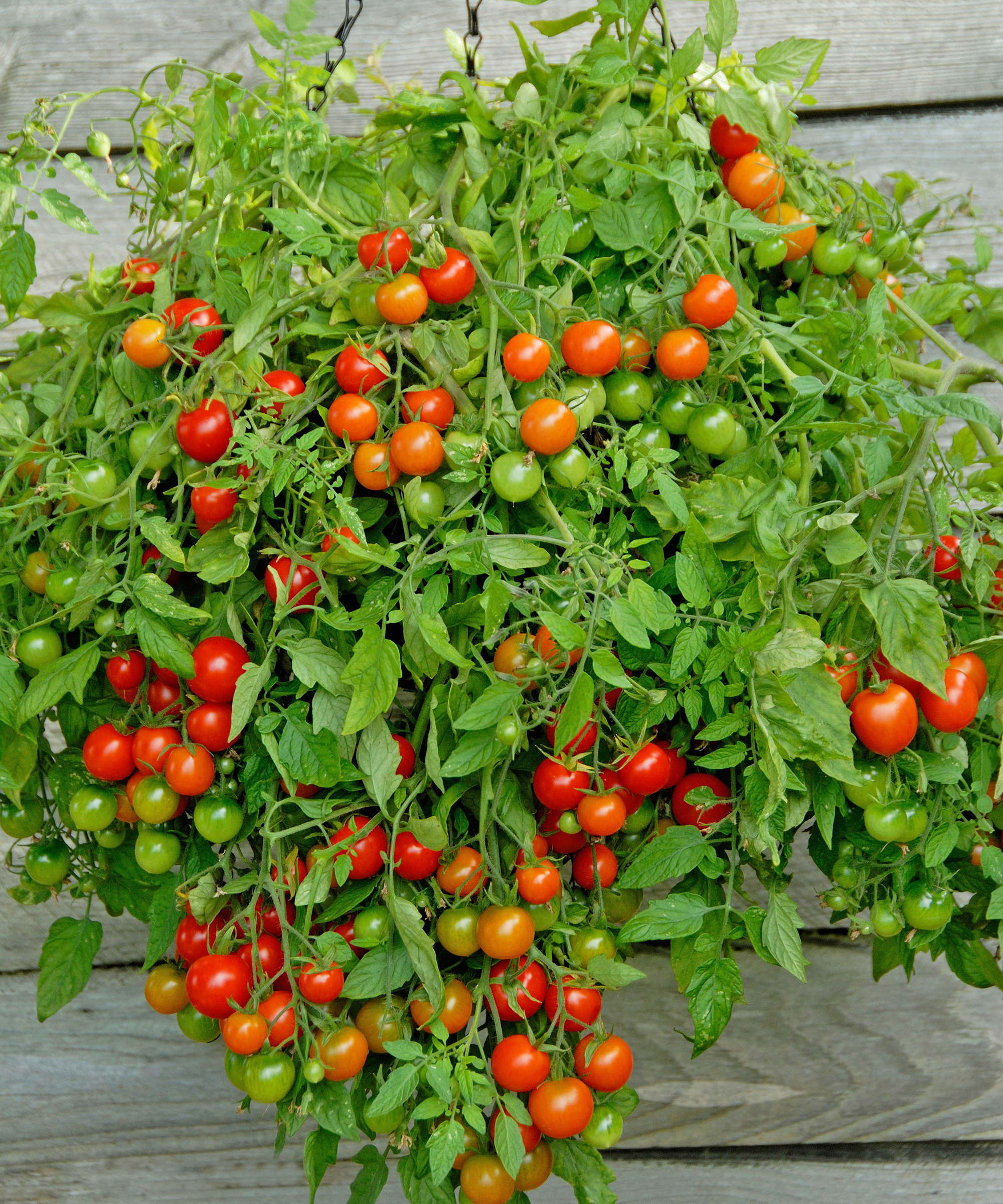
Fertilizer
Tomatoes need plenty of nutrients to produce those lovely orbs. Start with soil that has been enriched and start feeding at planting. Use a starter fertilizer initially to give the plant a boost of nutrients for root formation and stem and leaf production.
Once the first flowers begin to form, the best fertilizer for tomatoes is a low-nitrogen, phosphorus-heavy water soluble formula, applied every two to three weeks. This is more often than in-ground plants because the roots don’t have access to nutrients in the confined site. You can further enrich plants by making your own homemade tomato fertilizer.
Make sure to water fertilizer in well and avoid getting it on the leaves. The best time to feed the plant is morning when it can readily uptake the liquid nutrients.
Supporting Tomatoes in Pots
Compact, bushy tomato plants in containers may need no support at all. For more vigorous varieties, tomato cages are readily available and will fit inside most suitable containers. Install them when the plant is young and begin training the stems early.
Staking tomatoes is another way to provide support – simply insert stakes strung across with twine. A sturdy trellis is also effective but will require the stems to be tied to the struts.
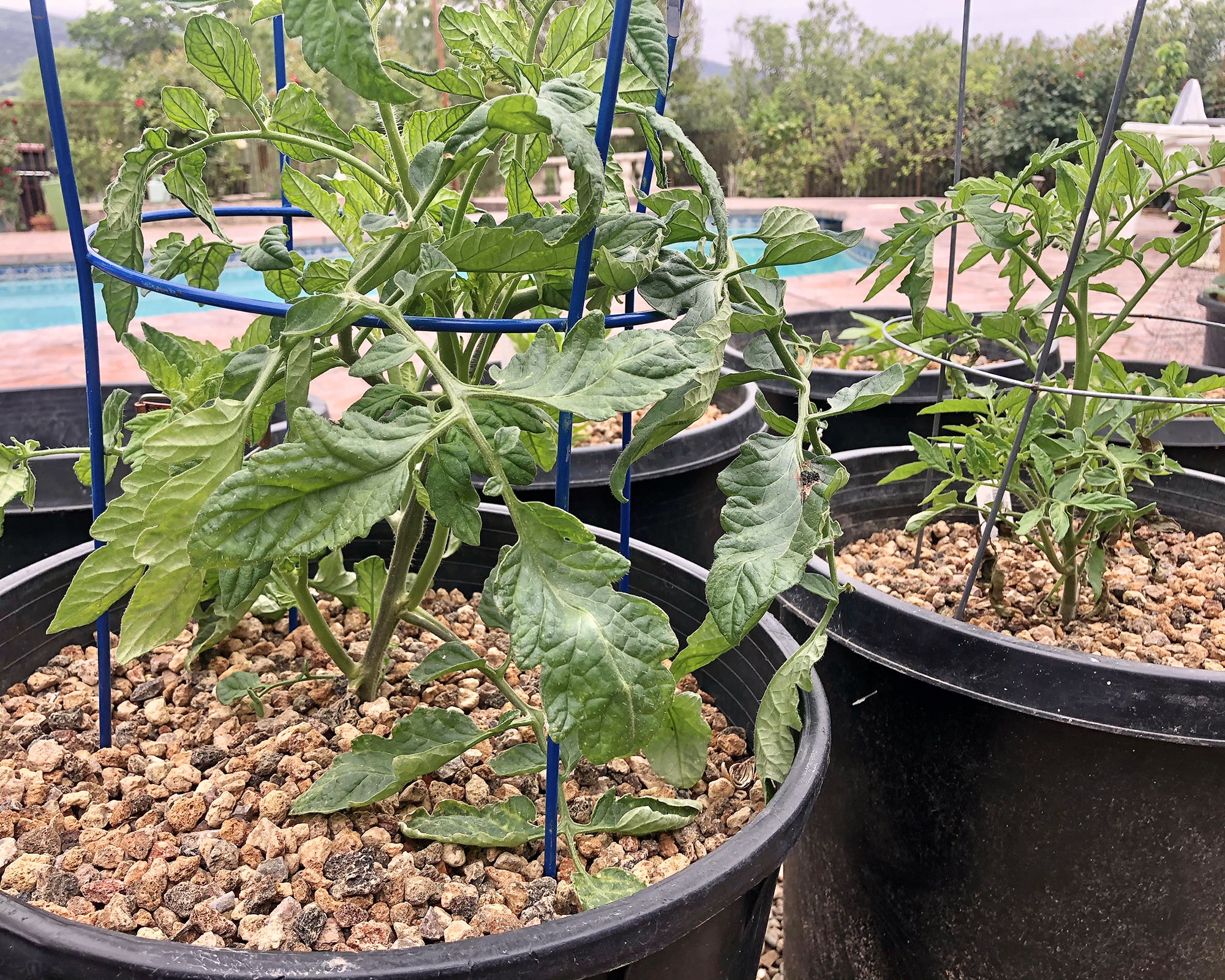
Harvesting
The time for harvesting container-grown tomatoes varies. For determinate varieties, the fruit is ready nearly all at once, but for indeterminate tomatoes, the fruits can keep coming all season long.
Pick tomatoes when they are glossy, firm with a slight give, and have reached peak color. If a cold snap is threatening to come take your plant, harvest all the fruit and place the ones that aren’t ripe in a paper bag. They will ripen over time.
Problems, Pests & Diseases
Over or under watering, lack of support, inadequate nutrients, and too little sun are common tomato problems that can cause plant health to decline in a container.
In addition, pests love tomatoes as much as we do. There is a long list of tomato plant pests that will pester your plant. Be vigilant and hand-pick off larger pests, such as tomato hornworms. Use homemade insecticidal soap to combat sucking insects like aphids, or spray them off with a blast of water during the day when the leaves have plenty of time to dry before nightfall. Consider using a row cover to protect young plants from flying insects that lay eggs that will become damaging larvae.
Many tomato diseases can be prevented by using fresh soil, selecting disease-resistant tomatoes, and avoiding water practices that will keep leaves wet and create overly saturated soil.
More Tomato Growing Inspiration
- Learn the secret to growing perfect tomatoes with expert tips from a chef-turned-gardener.
- Start a vegetable garden on the patio with our Ultimate Container Seed Collection, available in the Shop.
- Try the 6 best early tomatoes that ripen fast and still taste amazing.
- Discover how to increase tomato yields with these 7 expert tricks for a bumper harvest.
- Still want to know more about growing your own tomatoes? Download our free eBook, How to Grow Delicious Tomatoes
This article features products available from third-party vendors on the Gardening Know How Shop.

Bonnie Grant is a professional landscaper with a Certification in Urban Gardening. She has been gardening and writing for 15 years. A former professional chef, she has a passion for edible landscaping.
- Melanie GriffithsEditor in Chief


